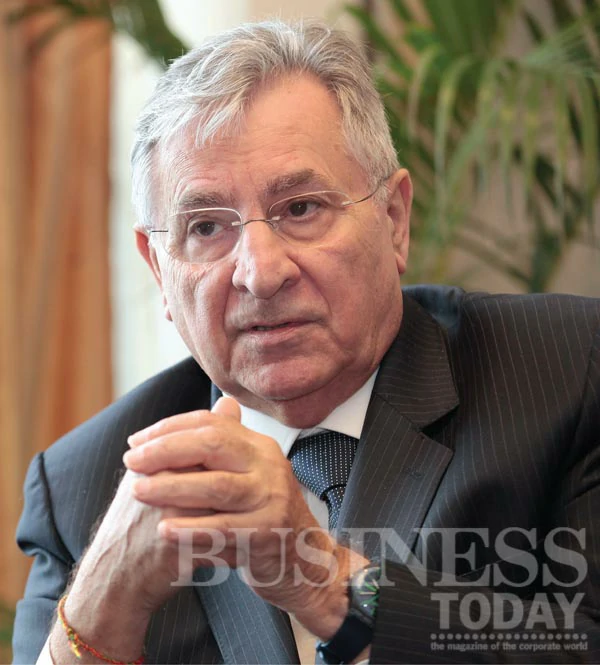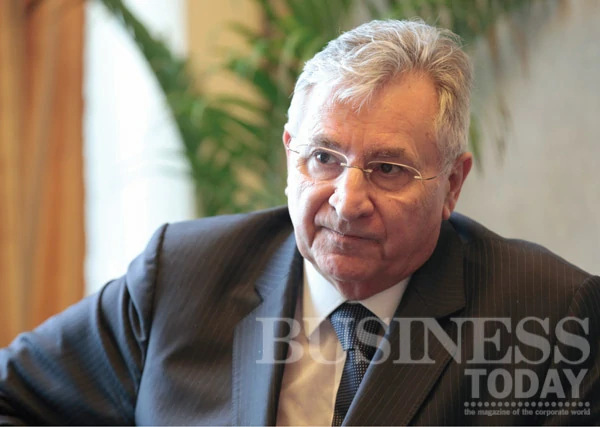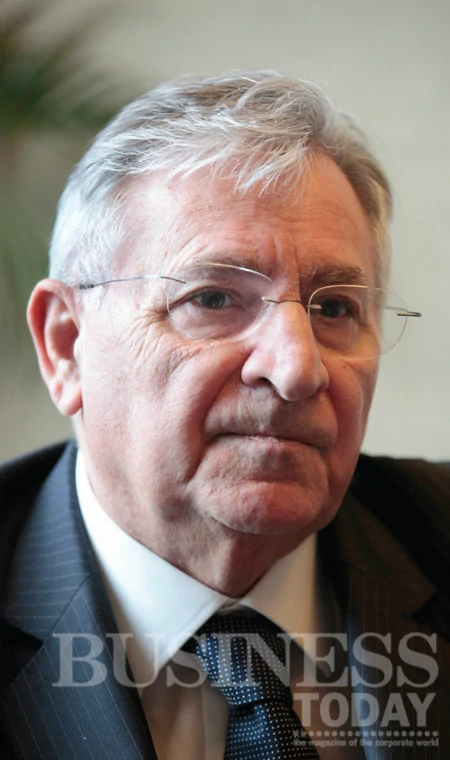
The CMA CGM group has grown by leaps and bounds to be considered as the third largest shipping company in the globe. With more than 650 Offices world-wide and calling in 400 ports weekly, their presence could be felt far and wide. Farid T Salem, Executive Officer of CMA CGM who was present in Colombo to participate in the inauguration of the new Breakwater and the Colombo International Terminal revealed the opportunities that Sri Lanka may have with these new developments while stressing the importance of capturing the opportunities that come our way.
By Krishani Peiris Photography Menaka Aravinda
The new Colombo International Container Terminal and the new Breakwater were just inaugurated. What are your thoughts on these milestones?
It is a very good progress and another step forward. Now, Sri Lanka can play its part internationally, in the major ports league. There were two inaugurations. The first one was of the Breakwater and the second one was of the Colombo International Terminal.
The Breakwater was built by the Sri Lanka Port Authority in a public-private partnership with funds advanced by the Asian Development Bank. The CICT, on the other hand, was completely funded by China Merchants Holdings, who will equip and operate the Terminal. This is a very important development as this is the first time in Colombo where you have a terminal with an 18 metre deep basin. That means that vessels of 11,000 TEUs can now arrive with
a full load. This is a significant development as it now opens avenues for Sri Lanka to carry out trade at a larger scale.
In recent years Sri Lanka has given significant prominence to building new ports and developing the maritime industry of the country, especially in Colombo. How will this benefit the country as a whole as well as the city of Colombo?
Colombo is ideally and strategically located in the subcontinent. Therefore, as it is the case with CMA CGM, containers could be feedered in Colombo and subsequently be relayed on main liner vessels to East Africa, West Africa, North Europe, Far East, America and so on. The new Colombo International Terminal that was inaugurated confirms this strategic situation and reinforces it even more with larger deep sea vessels with 18 container rows and over 15 m draft can now call on Sri Lanka and boost the trade.
The CMA CGM group operates six services in Colombo which trade to Russia, North Europe, the Mediterranean, Australia, East Africa, and West Africa. We will continue serving these destinations while developing our business with mega vessels.
These developments, especially the recent developments, benefit Sri Lanka in two ways. First, it will maintain and develop the normal trade of the Colombo Port. The second one is more important. It’s the status of Free Port that President Mahinda Rajapaksa recently declared. Now, you can establish manufactures in the area of the port which can produce and
export. This decision is of paramount importance as it can put Colombo on par with Jebel Ali Free Zone adjacent to the port in Dubai. Furthermore, the Port could also be used as a warehouse to store goods for distribution companies before delivery to their final destinations. Therefore, in my opinion, the port of Colombo has the potential of creating thousands of jobs.
“We Were More Hands On In How To Do The Business And How To Be Sharp In Order To Get The Opportunities When They Came By. When Opportunity Presents Itself We Have To Grab It. ”
Created in 1978, the CMA CGM Group has completed 35 years and has grown to become the third largest container shipping company in the world. All this was accomplished in a very competitive industry that has grown by bounds in the recent past. What were the reasons behind this success and how has this growth contributed to Sri Lanka?
The first reason behind CMA CGM growth is an objective one. Some years ago, not all goods were transported in containers. However, through time, goods were more and more containerised. Each year, the container business grew by about 15 to 20 per cent as more goods were manufactured and shipped in containers. Now, did we outgrow some of our competitors? Probably. Why, because we were more hands-on in our way of doing business and able to seize opportunities when we saw one. When opportunity arises, we had to grab it and there were many which we seized thus contributing to our growth. Perhaps, some other operators took more time to get hold of these opportunities and they were left behind.
The CMA CGM Group focuses on one activity, that is container shipping and we want to keep it that way for it is what we know and do best. Furthermore, containers nowadays act as the ultimate tool to carry goods – be they finished, semi-finished or even in bulk. I feel containers have paved the way for extraordinary growth in exchange which helps to foster globalisation, which has been happening since 20 years ago.
A few years ago, we operated a single service in Colombo, which was connecting Europe with the Far East via Sri Lanka. Today we run six services. We have developed our activity in Colombo six-fold compared with six or seven years ago. This proves, first of all that the Colombo Port is a good port otherwise, we would not have chosen Colombo to develop our activities. A second important factor is, while developing CMA CGM activities, we were also contributing to the growth of the ports that we were serving, also contributing to the development of their respective countries as well.
There are several subsidiary companies that help along in the success of the CMA CGM Group and they are mainly divided into three sections such as container shipping, multimodal and services. Which section is the largest contributor to the success of the company and why?
Shipping is by far the largest contributor to the success of the CMA CGM Group with the majority of our revenues still generated by Liner Shipping. Revenues from Intermodal and Port Terminals are less because we started them later on and they haven’t reached the same magnitude. Furthermore, we have invested significantly in the container shipping sector and when one invests, one expects some return. Return of Investment has been materialised by the addition of very large vessels to our fleet and we have more very large vessels in our order books. Globalisation is a main driver in Liner Shipping and being global, CMA CGM carries on its vessels cargo for destinations beyond the scope of service such as North and West Africa or South America on board our Far East to Europe Service, cargo which will be relayed via our major “hubs”.
We have 650 offices worldwide to secure cargo and accept booking orders. They have developed close relationships with our customers and a CMA CGM customer anywhere in the world who wants to ship from one place to another will find us in both places ready to assist. We call on 400 ports every week and being global is a prerequisite to be profitable.
There are 650 agencies and offices of CMA CGM worldwide with 63-64 established solely in China. What was the reason behind giving prominence to China and how has this strategy helped the company and do you plan to give more prominence to Sri Lanka in the future?
The strategic decision to position ourselves in China has proven to be decisive in our success. We started our services from China in 1992, at a time where there were very few such companies in the country. Because we believed in China and in the fact that the working force in the country was ready to manufacture at more competitive prices than anywhere else in the world, we expanded in China and opened up our offices in its ports where we sent our vessels. We were right to do so and about approximately 25 per cent of our profits now come from China.
With regard to Sri Lanka, the country will have the same opportunity, the moment it starts to manufacture and produce goods for exports with the added advantage that it will not have to build a port as it already has one of the best in the area. When China started, it did not have an efficient port. In China, production of manufactured goods for exports started without the proper port infrastructure. Here, in Sri Lanka, you are fortunate as you already have ports. Therefore, if you start to manufacture, you have all chances of surpassing everybody, more so as your population is educated and that is an important factor.
“We Wanted Our Company’s Presence In Sri Lanka And To Grow Up In Sri Lanka – Mainly In Colombo By Trading Between Sri Lanka And Other Places. Also We Wanted To Make Colombo A Centre Of Trans-Shipment For Some Of Our Cargo…”
The CMA CGM established a representative in Sri Lanka many years ago. What was the main reason for initiating a company in Sri Lanka and what can you say about the progress of the company?
The shareholders of CMA CGM Lanka are the Hayleys group and CMA CGM. We hold 100 if not 99 per cent of the shares in all our representative agencies. We have maintained this perspective, because in globalisation you have one operating system from booking to invoicing. If you are operating through third parties equipped with their own IT systems, it does not work efficiently. That is why all major shipping lines conduct their systems the same way as us. Furthermore, this also helps and adds up to the business. You add all the bits and pieces and one day you can say, as an example, I am number three.
We wanted our company to be present in Sri Lanka and to grow up in Sri Lanka – mainly in Colombo by trading between Sri Lanka and other places. Also we wanted Colombo to become a centre of trans-shipment for some of our cargo that we book in the East or West Coasts of India and Bangladesh. And we have been very successful in this operation. The Director General of the CMA CGM representative in Colombo is on top of all the operations and does the job very well. Therefore, the growth of the company in Sri Lanka has been very satisfactory when compared with the capacity capabilities of today. However, there’s still room for improvement and growth.
One of the main objectives of Sri Lanka is to become a maritime hub and we are steadily progressing in order to make this objective a reality. How plausible is this objective? If so what are the main attributes that Sri Lanka possesses in making this a reality?
Colombo, Sri Lanka now has the status of free port – where manufactured goods for exports are tax free. Now
Sri Lanka has to attract major manufacturing companies to come and install their production plants in the country. The working force is educated and therefore, the knowledge can easily be put into manufacturing. However, in order to do so, the country has to attract these needed manufacturers. For example, I visited Lagos in Nigeria sometime back. Two hours from Lagos, there is a logistic park – a place where small and medium manufacturers are manufacturing products for re-exporting. Who is conducting this facility? The Chinese are. They are exporting their manufactured items to places which are less competitive. Therefore, here Sri Lanka has a real potential and what you have to do is to attract investors.
Another attraction for investors is that in Sri Lanka taxation is relatively mild in terms of income tax on companies and people. Accordingly
Sri Lanka has most of the ingredients for people to come and invest.
Manufacturing in Vietnam didn’t meet original expectations and I am sure that Sri Lanka can take over.
But you would not be able to succeed by sitting back and saying I have a port and the Holy Spirit come down and provide. You have to work hard for it. We are here in Sri Lanka and CMA CGM, we will do everything to make its presence in Sri Lanka be more comprehensive and active.
It is believed that the growth of the shipping industry is an important factor for economic growth. What are your thoughts in this regard? And how do you see the role of the shipping industry contributing towards the development of Sri Lanka?
When you talk about economic growth, there are two points to consider. The first one is exports and the second is local consumption. When you take exports, the best way to carry your cargo is by sea as it is the cheapest and somehow the fastest. Therefore, you measure the growth of a country in terms of access to shipping. As an example, if Sri Lanka needed to export and did not have a port, you would not be able to ship it anywhere and that would create a problem. It is important that a country has a port that is accessible to every destination.
“Manufacturing In Vietnam Has Not Succeeded And I Am Sure That Sri Lanka Can Take Their Place… And At CMA CGM We Will Do Everything To Make Our Presence In Sri Lanka More Comprehensive And Active.”
What are the challenges faced by the shipping industry overall, especially with the current economic crisis that is prevailing globally, and what challenges do you think affects CMA CGM the most?
Unfortunately, the major challenge is overcapacity – too many ships for reducing volumes of containers. This is a situation which arose in 2013 except during the months of July, August and September – the so called “Peak season” during which Europe and America import to replenish their stocks for the Christmas season. But besides these three months, there is an overcapacity of ships today. What do shipping lines do to tackle such issues? It is a fact that shipping lines want more efficient vessels. For example a few years ago, vessels of 9,000 TEUs were 340 metres in length and were burning much fuel, whereas now the same capacity vessels are 300 metres in length and consume 30 per cent less fuel. And when you pay about USD 120,000 per day for fuel, this reduction means a lot. Therefore, shipping companies are looking for more efficient and economical ships to sustain the fuel situation. Subsequently, overcapacity is the major issue, certainly for at least the next two years.
To overcome this challenge, we, similar to many other operators have reduced the number of ships on order. We have also postponed deliveries of new buildings to 2015 and 2016. GDP increases every year, but the important thing is that the number of vessels does not increase.
The environmental damage done by the shipping industry has given some plausible concerns over the years. What has CMA CGM done to address these issues?
To put it simply, transportation by sea is one of the least polluting modes of transport – less than aircraft, trains, cars, trucks and so on. Furthermore, CMA CGM CO2 emission per TEU/Km is, if not the best, one of the best.
When the vessel is old – what to do with it and how to discard it? Can pollution occur in the process? It depends. If you are dismantling a ship, if there are some asbestos, it might cause some pollution. But ships built since the past 10 years are free of asbestos.
However, maybe the conditions in which the ship is dismantled, especially the working conditions, need to be improved.
What are the future plans of the company?
First, locally we want to concentrate more of our services in Colombo, by bringing in more and bigger vessels. Globally we have two strategies. One is we will be partnering with major shipping lines, Maersk and MSC in the future, forming an association called the P3 Network – Partner Three – where we are joining forces on trade in Asia-Europe, Asia-USA and Europe-USA Trades. We will put our vessels together to offer a better alternative to the customer. Because at the end of the day we work for the customer as he/she makes our living. The other point is we will continue our development in Africa and South America, and this development will be on the shipping side.







